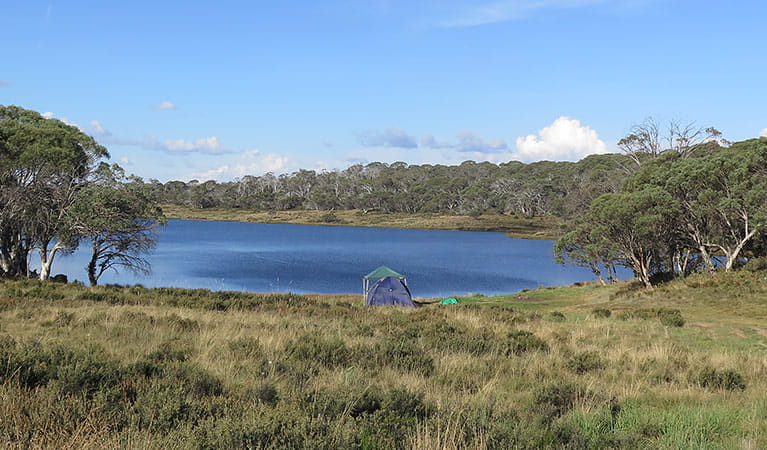Three Mile Dam campground
Selwyn area in Kosciuszko National Park
Overview
Set up camp at lakeside Three Mile Dam campground, a great base to explore the walks, mountain biking, fishing, and cross-country skiing in central and northern Kosciuszko National Park, near Kiandra and Selwyn snowfields.
| Camping type | Tent, Camper trailer site, Caravan site, Camping beside my vehicle |
|---|---|
| Facilities | Picnic tables, barbecue facilities, carpark, toilets |
| What to bring | Firewood |
| Opening times | The gates to this campground are closed from the June long weekend to October long weekend. Camping is still possible for walkers; please park in the Goldseekers track carpark on Link Road. |
| Price | There are no camping fees at this campground but a $6 booking fee applies. |
| Group bookings | Bookings for up to 5 sites and 20 people can be made online. School groups and commercial tour operators can submit a group booking enquiry form. |
| Please note |
|
As well as being unbeatable for fishing, bushwalking and a good dose of outdoor relaxation, Three Mile Dam campground offers Aussie heritage in spades.
Established during the Kiandra gold-mining era, the dam provided water for sluicing operations via race lines to Kiandra (New Chum Hill). Its eastern side was part of the Snowy Mountains Hydro Electric Scheme.
There are no marked sites but you’ll find plenty of room for your tent, camper trailer or caravan amidst the grassy sub-alpine woodland. Bask in the shelter of the surrounding snow gums, and make use of the handy facilities including barbecues and picnic tables.
It’s a good spot to visit in warmer weather as a stopover on the Khancoban to Kiandra scenic drive or Snowy Mountains Highway. A carpet of snow daisies and billy buttons enhance a springtime camping trip.
Map
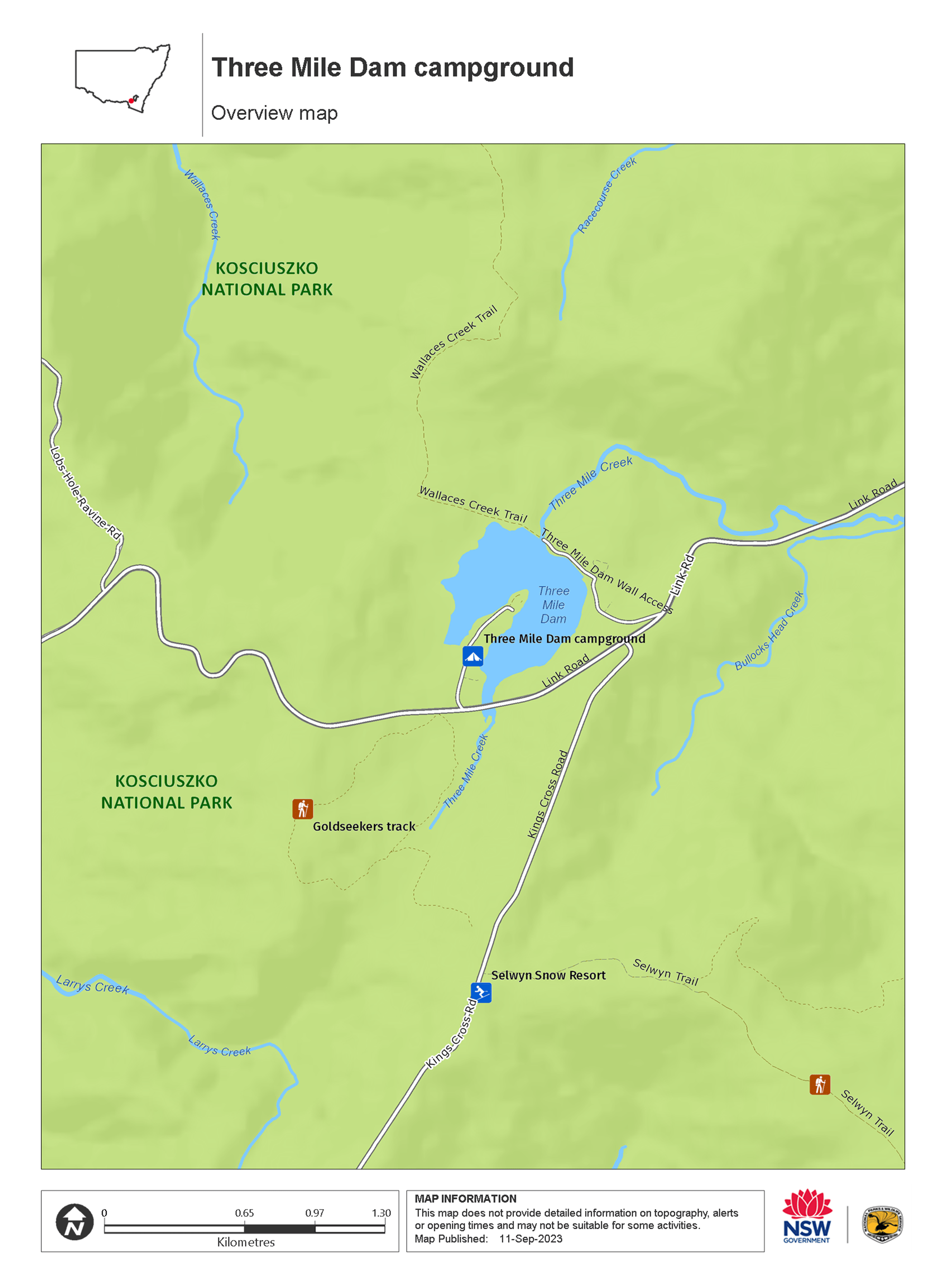
Map legend

Local alerts
For the latest updates on fires, closures and other alerts in this area, see https://www.nationalparks.nsw.gov.au/camping-and-accommodation/campgrounds/three-mile-dam-campground/local-alerts
Bookings
- National Parks Contact Centre
- 7am to 7pm daily
- 1300 072 757 (13000 PARKS) for the cost of a local call within Australia excluding mobiles
- parks.info@environment.nsw.gov.au
Operated by
- Tumut Region Visitor Centre
- 9am to 5pm daily. Closed Christmas Day.
- 02 6947 7025
- tumutrvc@environment.nsw.gov.au
- The Old Butter Factory, 5 Adelong Road, Tumut NSW 2720
Park info
- in the Selwyn area of Kosciuszko National Park in the Snowy Mountains region
The Selwyn area is open all year, but some roads and trails may close due to weather conditions or park management issues. Kings Cross Road and the Khancoban-Cabramurra Road are closed in winter (June to October long weekends). Some campgrounds in the Selwyn area close in winter.
-
Park entry fees apply in winter on Link Road
June to October long weekends: $29 per vehicle per day (24hrs from purchase); motorcycles $12; bus passengers $11.45 per adult, $3.60 per child per day (24hrs). Single and Multi-Day passes available from entry stations, NPWS visitor centres, pay machines or via the Park'nPay app.
See vehicle entry fees for other areas in Kosciuszko National Park.
Buy annual pass.
Visitor info
All the practical information you need to know about Three Mile Dam campground .
Getting there and parking
Three Mile Dam campground is located in the Kiandra Selwyn area of Koscciuszko National Park.
To get there from Tumut or Adaminaby via Kiandra:
- Drive 75.5km south of Tumut, or 37.7km east of Adaminaby, along Snowy Mountains Highway
- Take the Kiandra-Cabramurra Road turn-off (signposted Link Road).
- Three Mile Dam campground is 5.8km on your right
To get there from Khancoban via Cabramurra (closed winter):
- Take Alpine Way west from Khancoban for 5.8km to the Swampy Plains Creek Road turnoff
- Follow the signs for 60km to the Cabramurra turn-off
- From here, follow Goat Ridge Road, then turn right at Link Road towards Kiandra
- Three Mile Dam is around 9.6km on your left
The gates to this campground are closed from the June long weekend to October long weekend. Camping is still possible for walkers; please park in the Goldseekers track carpark on Link Road.
Road quality
It's recommended that all vehicles carry snow chains from the June to October long weekends. Read our snow driving in Kosciuszko tips.
- Unsealed roads
Vehicle access
- 2WD vehicles
Weather restrictions
- Snow chains required after snow
Parking
Parking is available at most of the campsites.
From the June long weekend to the October long weekend, the gates to the campground are closed and the campground is walk-in access only. If you plan to walk to the campground, please park in the Goldseekers track carpark on Link Road.
Facilities
Dam water is available at this campground, but you’ll need to treat or boil it before drinking.
Toilets
- Non-flush toilets
Picnic tables
Barbecue facilities
- Wood barbecues (bring your own firewood)
Carpark
Maps and downloads
Permitted
Fishing
A current NSW recreational fishing licence is required when fishing in all waters.
Generators
Prohibited
Drones
Flying a drone for recreational purposes is prohibited in this area. Drones may affect public enjoyment, safety and privacy, interfere with park operations, or pose a threat to wildlife. See the Drones in Parks policy.
This area may be a declared Drone Exclusion Zone, or may be subject to Civil Aviation Safety Authority (CASA) rules for flying near airports, aerodromes and helicopter landing sites. See CASA's Drone Flyer Rules.
Commercial filming and photography
Commercial filming or photography is prohibited without prior consent. You must apply for permission and contact the local office.
Pets
Pets and domestic animals (other than certified assistance animals) are not permitted. Find out which regional parks allow dog walking and see the pets in parks policy for more information.
Smoking
NSW national parks are no smoking areas.
Learn more
Three Mile Dam campground is in Selwyn area. Here are just some of the reasons why this park is special:
Kiandra's claims to fame
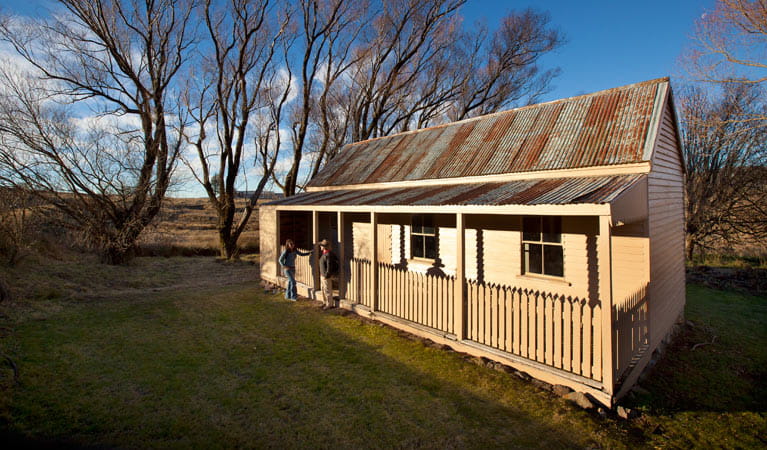
The discovery of gold at Kiandra in 1859 attracted up to 10,000 prospectors hoping to strike it rich. Just 18 months later, after harsh winters and falling gold finds, only a few hundred gold miners remained. It's remembered as one of Australia’s shortest gold rushes, not to mention it’s highest (and coldest). In 1861, Kiandra became the birthplace of skiing in Australia, when Norwegian gold miners fashioned skis from fence palings. By the 1870s regular ski carnivals were arranged, and Australia had its first official ski slope here. Mining continued into the 1930s, with grazing and winter skiing also keeping the community alive. Before devastating fires in 2019-2020, four buildings still stood here, including Kiandra Courthouse, which had served as a courthouse, private residence, ski chalet, hotel and bar.
Plants and animals protected in this park
Animals
-

Bare-nosed wombat (Vombatus ursinus)
A large, squat marsupial, the Australian bare-nosed wombat is a burrowing mammal found in coastal forests and mountain ranges across NSW and Victoria. The only other remaining species of wombat in NSW, the endangered southern hairy-nosed wombat, was considered extinct until relatively recently.
-
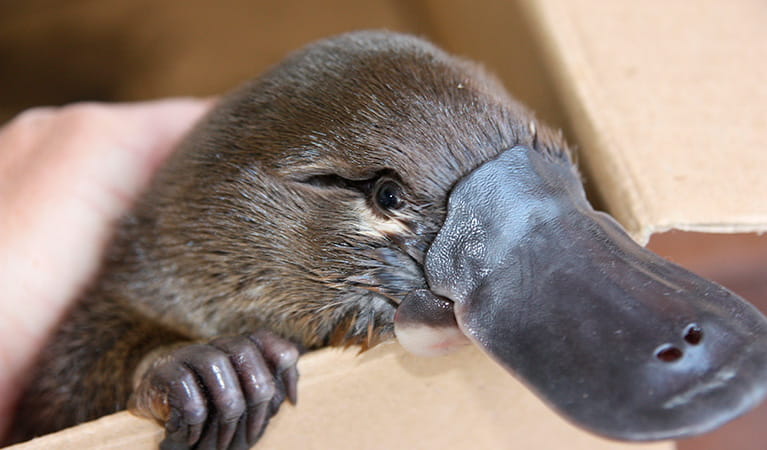
Platypus (Ornithorhynchus anatinus)
One of the most fascinating and unusual Australian animals, the duck-billed platypus, along with the echidna, are the only known monotremes, or egg-laying mammals, in existence. The platypus is generally found in permanent river systems and lakes in southern and eastern NSW and east and west of the Great Dividing Range.
-
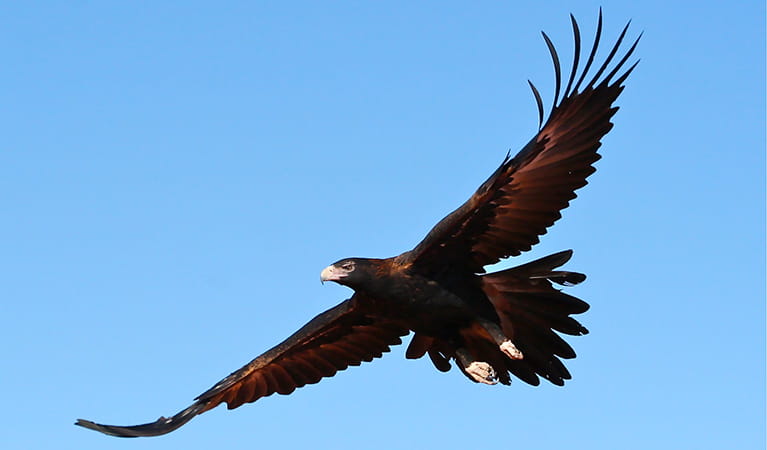
Wedge-tailed eagle (Aquila audax)
With a wingspan of up to 2.5m, the wedge-tailed eagle is Australia’s largest bird of prey. These Australian animals are found in woodlands across NSW, and have the ability to soar to heights of over 2km. If you’re bird watching, look out for the distinctive diamond-shaped tail of the eagle.
Plants
-
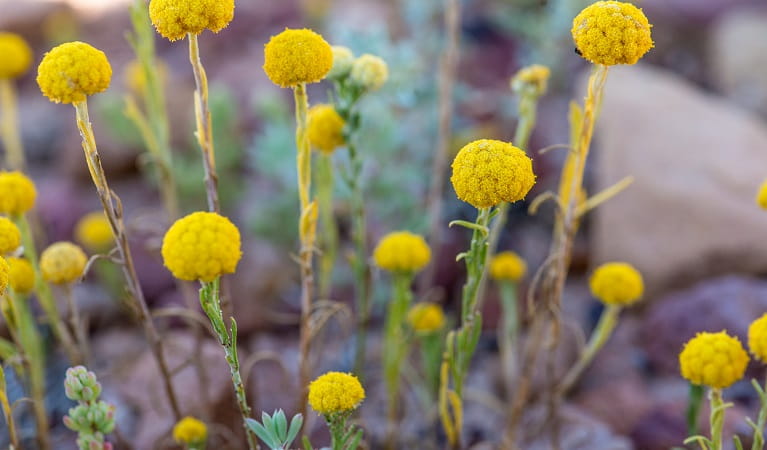
Billy buttons (Craspedia spp. )
Billy buttons are attractive Australian native plants that are widespread throughout eastern NSW in dry forest, grassland and alpine regions such as Kosciuszko National Park. The golden-yellow globe-shaped flowers are also known as woollyheads. Related to the daisy, billy buttons are an erect herb growing to a height of 50cm.

